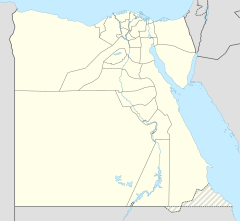| Merneptah Stele | |
|---|---|
 The stele in 2023 | |
| Material | Granite |
| Writing | Ancient Egyptian hieroglyphs |
| Created | c. 1208 BCE |
| Discovered | 1896 Thebes, Egypt 25°43′14″N 32°36′37″E / 25.72056°N 32.61028°E |
| Discovered by | Flinders Petrie |
| Present location | Egyptian Museum, Cairo |
| Identification | JE 31408 |
| Period | New Kingdom of Egypt |
The Merneptah Stele was discovered in Thebes and is currently housed in Cairo, Egypt | |
The Merneptah Stele, also known as the Israel Stele or the Victory Stele of Merneptah, is an inscription by Merneptah, a pharaoh in ancient Egypt who reigned from 1213 to 1203 BCE. Discovered by Flinders Petrie at Thebes in 1896, it is now housed at the Egyptian Museum in Cairo.[1][2]
The text is largely an account of Merneptah's victory over the ancient Libyans and their allies, but the last three of the 28 lines deal with a separate campaign in Canaan, then part of Egypt's imperial possessions. It is sometimes referred to as the "Israel Stele" because a majority of scholars translate a set of hieroglyphs in line 27 as "Israel". Alternative translations have been advanced but are not widely accepted.[3]
The stele represents the earliest textual reference to Israel and the only reference from ancient Egypt.[4] It is one of four known inscriptions from the Iron Age that date to the time of and mention ancient Israel by name, with the others being the Mesha Stele, the Tel Dan Stele, and the Kurkh Monoliths.[5][6][7] Consequently, some consider the Merneptah Stele to be Petrie's most famous discovery,[8] an opinion with which Petrie himself concurred.[1]
- ^ a b Drower 1995, p. 221.
- ^ Redmount 2001, pp. 71–72, 97.
- ^ Sparks 1998, pp. 96–.
- ^ Hasel 1998, p. 194.
- ^ Lemche 1998, pp. 46, 62: "No other inscription from Palestine, or from Transjordan in the Iron Age, has so far provided any specific reference to Israel... The name of Israel was found in only a very limited number of inscriptions, one from Egypt, another separated by at least 250 years from the first, in Transjordan. A third reference is found in the stele from Tel Dan – if it is genuine, a question not yet settled. The Assyrian and Mesopotamian sources only once mentioned a king of Israel, Ahab, in a spurious rendering of the name."
- ^ Maeir, Aren. Maeir, A. M. 2013. Israel and Judah. pp. 3523–27, The Encyclopedia of Ancient History. New York: Blackwell.
The earliest certain mention of the ethnonym Israel occurs in a victory inscription of the Egyptian king Merenptah, his well-known "Israel Stela" (c. 1210 BCE); recently, a possible earlier reference has been identified in a text from the reign of Rameses II (see Rameses I–XI). Thereafter, no reference to either Judah or Israel appears until the ninth century. The pharaoh Sheshonq I (biblical Shishak; see Sheshonq I–VI) mentions neither entity by name in the inscription recording his campaign in the southern Levant during the late tenth century. In the ninth century, Israelite kings, and possibly a Judaean king, are mentioned in several sources: the Aramaean stele from Tel Dan, inscriptions of Shalmaneser III of Assyria, and the stela of Mesha of Moab. From the early eighth century onward, the kingdoms of Israel and Judah are both mentioned somewhat regularly in Assyrian and subsequently Babylonian sources, and from this point on there is relatively good agreement between the biblical accounts on the one hand and the archaeological evidence and extra-biblical texts on the other.
- ^ Fleming, Daniel E. (1998-01-01). "Mari and the Possibilities of Biblical Memory". Revue d'Assyriologie et d'Archéologie Orientale. 92 (1): 41–78. JSTOR 23282083.
The Assyrian royal annals, along with the Mesha and Dan inscriptions, show a thriving northern state called Israël in the mid—9th century, and the continuity of settlement back to the early Iron Age suggests that the establishment of a sedentary identity should be associated with this population, whatever their origin. In the mid—14th century, the Amarna letters mention no Israël, nor any of the biblical tribes, while the Merneptah stele places someone called Israël in hill-country Palestine toward the end of the Late Bronze Age. The language and material culture of emergent Israël show strong local continuity, in contrast to the distinctly foreign character of early Philistine material culture.
- ^ The Biblical Archaeologist, American Schools of Oriental Research, 1997, p. 35.
